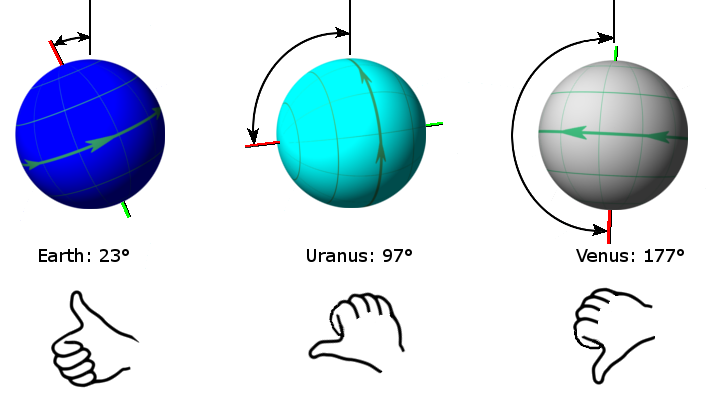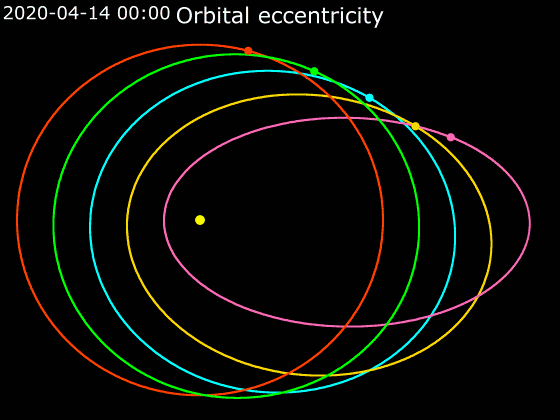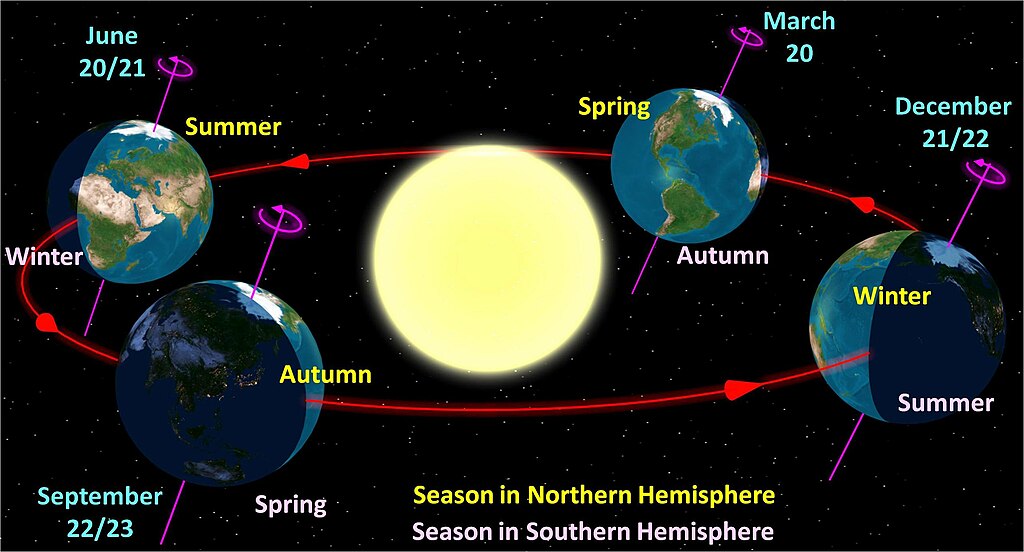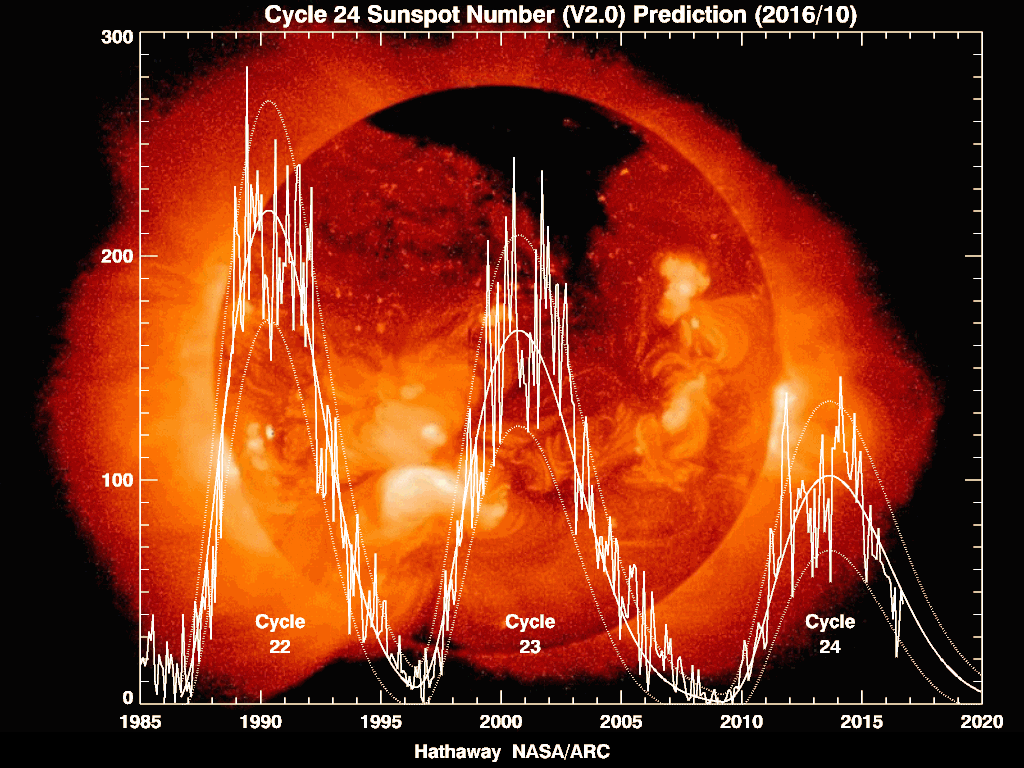Unveiling Secrets of Climate of the Earth | Earth has regularly alternated between glacial periods and interglacial periods
The climate of the Earth is a fascinating puzzle, and at the heart of understanding its fluctuations, which have caused the Earth to regularly alternate between glacial periods and interglacial periods over the past 2 million years, lies the work of Serbian astronomer Milutin Milanković.
It’s like a natural pattern of the Earth’s climate switching between cold and warm phases. In fact, these glaciations and deglaciations are directly linked to the sunshine the Earth receives or to the heat it receives.

Milankovitch cycles orbit and cores. Incredio, CC BY 3.0, via Wikimedia Commons
3 Astronomical parameters influence the Earth’s climate, causing it to switch between cold and warm phases
This visionary scientist unveiled three crucial astronomical parameters that play a significant role in shaping our climate of the Earth:
1. Earth’s Obliquity: The Tilt That Guides the Seasons
The Earth’s axial tilt (inclination), known as obliquity, is like the planet’s seasonal compass. It ranges between 21.90 and 24.50 degrees, accentuating the differences between seasons. As the Earth orbits the sun, this tilt determines the extent of sunlight received, influencing the intensity of our seasons.

Comparison of the tilt of the rotation axis to the plane of the orbit for three planets: Earth, Uranus, Venus. Imagine a planet spinning like a top. If you use your right hand and curl your fingers in the same direction the planet is spinning, your thumb will point to the positive pole. The tilt of the planet’s spin compared to its orbit is called the axial tilt. For Earth, it’s about 23°; for Uranus, it’s around 97°, and for Venus, it’s roughly 177°. Tfr000 (talk) 13:49, 2 April 2012 (UTC), CC BY-SA 3.0, via Wikimedia Commons
2. Earth’s Eccentricity: A Cosmic Dance Around the Sun
While it takes the Earth roughly 365 days to complete its orbit around the sun, the path isn’t a perfect circle. Milanković introduced the concept of eccentricity, revealing that Earth’s orbit becomes more elliptical every 100,000 years. This cosmic dance influences our proximity to the sun, causing variations in the amount of heat we receive.

Elliptic orbit by eccentricity. Phoenix7777, CC BY-SA 4.0, via Wikimedia Commons
3. Precession of the Equinoxes: Earth’s Graceful Spin (The wobble in Earth’s orbit)
Picture the Earth spinning like a spinning top —this is the precession of the equinoxes. Over a staggering 23,000 years, the direction of the Earth’s axis of rotation shifts in a circular motion. This precession adds a fascinating twist to our seasons, ensuring they don’t occur consistently in the same locations.

Precession of Earth’s rotational axis due to the tidal force raised on Earth by the gravity of the Moon and Sun. Think of the Earth’s axis like a spinning top that wobbles over time. This wobbling is called precessional movement. The middle picture shows how this wobble changes where the Sun appears during the year (equinox). The right picture shows how the North Star changes over a really long time because of this wobble. Vega is a bright star that plays a role in this cosmic dance. NASA, Mysid, Public domain, via Wikimedia Commons
When the Earth is farther from the sun, temperatures cool down, impacting the global climate Climate of the Earth.

Apsidal precession—the orbit rotates gradually over time. WillowW, CC BY 3.0, via Wikimedia Commons
Precession of the ecliptic
Imagine Earth’s orbit is like a wobbly spin, going up and down. This wobble is called “orbital inclination.” Right now, Earth’s wobble is about 1.57 degrees compared to the Solar System’s main spin (kind of like Jupiter’s spin).
There’s another wobble called “precession of the ecliptic.” It’s like a twirl in Earth’s orbit dance. This twirl takes about 70,000 years to complete when we look at it from Earth. But if we look at it from a different angle, it’s more like 100,000 years.
Surprisingly, both these wobbles, the 70,000-year one and the 100,000-year one, match up with the timing of big ice ages on Earth. It’s like they’re all part of the same dance routine.

Imagine a spinning top. When you push or pull on its sides, it starts to wobble, and this wobbling is called precession. Similarly, the Sun and Moon’s gravitational pull on the Earth’s bulge makes our planet slowly wobble, a bit like the spinning top. This wobbling, caused by an off-center force, is called precession too. It’s like each part of the spinning Earth is trying to fall, but its rotation brings it back up, creating the overall effect of precession. Lucas Vieira, Public domain, via Wikimedia Commons
Milanković’s insights into these three astronomical phenomena help us decipher the rhythmic dance between ice ages and warmer periods. But, our exploration of Earth’s climate doesn’t stop here.

Milutin Milanković (1879–1958), a Serbian mathematician and astronomer, made significant contributions to global science. His major contributions include the “Canon of the Earth’s Insolation,” characterizing the climates of all the planets in the Solar System, and the explanation of Earth’s long-term climate changes known as Milankovitch cycles. This explanation partially accounts for past ice ages on Earth and forecasts future climate changes. [1], Public domain, via Wikimedia Commons

Over the last 500 million years, the Earth’s climate has gone through different phases. The graph shows the three major ice ages: Andean-Saharan (450 million years ago), Karoo (300 million years ago), and Late Cenozoic. There was also a milder cold period or ice age during the Jurassic-Cretaceous (150 million years ago). Dragons flight, CC BY-SA 3.0, via Wikimedia Commons
Two Additional Players: Mutation and Solar Cycles
Beyond Milanković’s triumvirate, we encounter two more influencers: mutation and solar cycles.
1. Mutation: In the context of the Earth’s orbit, “mutation” means small changes or variations in the way our planet moves around the sun.
Mutation, in this context, refers to variations in Earth’s orbit shape, adding another layer to the intricate climate puzzle.
Picture Earth like a graceful dancer twirling through space. This “dance” isn’t always the same; it has its variations, called mutations. These mutations can alter how sunlight is distributed across the planet. Depending on the dance move, some areas get more sunlight, and others get less. This shift in sunlight can influence temperatures, causing periods of colder climates (glacial) or warmer climates (interglacial).
Even Simpler: Think of it like tiny tweaks in the path Earth takes as it travels in space.

Imagine looking at the Earth from above, focusing on the four seasons—spring, summer, fall, and winter. This view is from the north, and we’re not thinking about the air around the Earth—no clouds, no twilight. The picture shows the Earth at different times as it goes around the sun during the year. Tauʻolunga, CC0, via Wikimedia Commons
2. Solar cycles: refers to the regular patterns of changes in the sun’s activity. It’s like the sun going through different moods over a set period.
Additionally, solar cycles, the rhythmic changes in the sun’s activity, contribute to the nuanced dance of Earth’s climate patterns.
Now, let’s talk about the Sun. It’s like a cosmic drummer, beating out rhythms in cycles. These solar cycles are the Sun’s way of changing its energy output. When the Sun cranks up the heat a bit or turns it down, Earth feels the impact. It’s like the Sun is playing with the thermostat of our planet. This subtle change in solar energy can nudge Earth’s climate, contributing to the alternating swings between glacial and interglacial periods.
Even Simpler: Imagine the sun having its own routine, where it sometimes gets more active and sometimes less, a bit like how we have different seasons on Earth.

The sun goes through cycles that last around 11 years. During these cycles, there are times when the sun is very active (solar maximum) and times when it’s less active (solar minimum), measured by counting sunspots. Scientists expected the sun to be super busy in 2013 with about 69 sunspots, and it turned out they were right. In 2016, the sun got even busier, and this second peak was bigger than the first one. However, compared to a really busy time in 1906, this cycle was on the smaller side. David Hathaway, NASA, Marshall Space Flight Center, Public domain, via Wikimedia Commons
Conclusion
In conclusion, the Earth’s climate is an orchestrated symphony conducted by astronomical elements. Milanković’s revelations about obliquity, eccentricity, and precession, combined with the subtle notes of mutation and solar cycles, form the celestial sheet music that guides our planet’s climate dance through time. Understanding these key players not only enriches our knowledge of Earth’s past but also provides insights into the ongoing rhythms of our climate today.
Sources: PinterPandai, NASA,
Photo credit: rihaij via Pixabay



